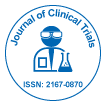
Journal of Clinical Trials
Open Access
ISSN: 2167-0870

ISSN: 2167-0870
Short Communication - (2021)
Samuel RM et al. reports that Androgen Receptor (AR) signaling regulates ACE2 and TMPRSS2 expression [1]. This observation suggests that COVID-19 susceptibility may be linked to androgenic hormones such as Testosterone (T) and Dihydrotestosterone (DHT) [1] and offers an explanation of why men are more susceptible to SARS CoV-2 infection than women or children. However, susceptibility to infection is now reported similar between sexes, as opposed to the clinical outcome and mortality rate, which is higher in men [2]. Linking circulating androgen to the cell viral entry and COVID-19 susceptibility appears an oversimplification, and additional genetic factors come into play and should be considered.
As AR signaling is inversely related to the number of polyQ repeats present in its N-terminus [3,4], we hypothesized and demonstrated that differences in the polyQ tract size might be an additional variable explaining differences in the epidemiology of COVID-19 between males and females [5]. Using an Italian cohort of COVID-19 (+) males, we found that COVID-19 severity is associated with AR alleles with polyQ repeats longer than 23. We also found that these men had higher serum T concentrations than men with <23Q, and explained that this is due to decreased negative feedback exerted at the hypothalamus and pituitary gland level by ARs carrying >23Q a phenomenon named “increased receptor resistance” [5].
Based on this, we have hypothesized and shown that despite serum T levels are elevated in men with AR >23Q, increased receptor resistance decreases the natural anti-inflammatory properties of T [5] and this phenomenon leads to an unopposed cytokine storm and to the theoretical possibility that T treatment with its anti-inflammatory properties should be considered in these individuals [5].
To determine whether other pathophysiological mechanisms causing abnormal cytokine production are associated with severe COVID-19 in males, we queried the COVID-19 section of the Network of Italian Genome (NIG) database (http:// www.nig.cineca.it/, specifically, http://nigdb.cineca.it) that houses more than 1000 Whole Exome Sequencing (WES) data of COVID-19 patients and SARS-CoV-2 infected asymptomatic subjects of the GEN-COVID consortium (https://sites.google.com/dbm.unisi.it/gen-covid) [6]. Specifically, we queried the already known L412F TLR3 functional polymorphism in life-threatening COVID-19 patients (G4 and G3) versus SARS-CoV-2 infected asymptomatic subjects (G0). The association was significant (p=0.036 chi-square test) and increased to p=0.001 if only males were considered, while was lost if only females were tested (p=0.46). We then investigated a synergistic effect between the two polymorphisms (polyQ in AR gene and L412F TLR3). As expected, neither an additive nor an epistatic effect was identified (p=0.06), confirming that the mechanisms are independent and opposite. Indeed, males are more susceptible to toll-like receptor defects since T after puberty sets the male gender vulnerable to infection [7], strongly decreasing native immunity axis.
In conclusion, in males where the COVID-19 pathophysiological mechanism is due to decreased native immunity, the antiandrogen therapy suggested by Samuel et al., could be considered adjuvant to interferon therapy. In contrast, in those males where the pathophysiological mechanism is due to cytokine storm and decreased AR function (e.g, receptor resistance), anti-androgen therapy might be hazardous even in the presence of normal or increased T levels. The observations reported here should lead to consider the use of T or antiandrogen therapy only in the appropriate and personalized context, specifically after genetic testing (polyQ in AR gene and L412F in TLR3) to identify the underlying pathophysiological mechanism.
This study is part of the GEN-COVID Multicenter Study, https://sites.google.com/dbm.unisi.it/gen-covid, the Italian multicenter study aimed at identifying the COVID-19 host genetic bases. Specimens were provided by the COVID-19 Biobank of Siena, which is part of the Genetic Biobank of Siena, member of BBMRI-IT, of Telethon Network of Genetic Biobanks (project no. GTB18001), of EuroBioBank, and of RDConnect. We thank the CINECA consortium for providing computational resources and the Network for Italian Genomes (NIG) http://www.nig.cineca.it for its support. We thank private donors for the support provided to A.R. (Department of Medical Biotechnologies, University of Siena) for the COVID-19 host genetics research project (D.L n.18 of March 17, 2020). We also thank the COVID-19 Host Genetics Initiative (https:// www.covid19hg.org/), MIUR project “Dipartimenti di Eccellenza 2018-2020” to the Department of Medical Biotechnologies University of Siena, Italy and “Bando Ricerca COVID-19 Toscana” project to Azienda Ospedaliero- Universitaria Senese. We also thank Intesa San Paolo for the 2020 charity fund dedicated to the project N. B/2020/0119 Identificazione delle basi genetiche determinanti la variabilità clinica della risposta a COVID-19 nella popolazione italiana.
Citation: Renieri A, Baldassarri M, Isidori A, Carriero ML, Marcelli M (2021) Coronavirus Disease 2019 and Androgens: An Intriguing Association. J Clin Trials. S9:001.
Received: 08-Jan-2021 Accepted: 21-Jan-2021 Published: 28-Jan-2021 , DOI: 10.35248/2167-0870.21.s9.001
Copyright: © 2021 Renieri A, et al. This is an open access article distributed under the terms of the Creative Commons Attribution License, which permits unrestricted use, distribution, and reproduction in any medium, provided the original author and source are credited.